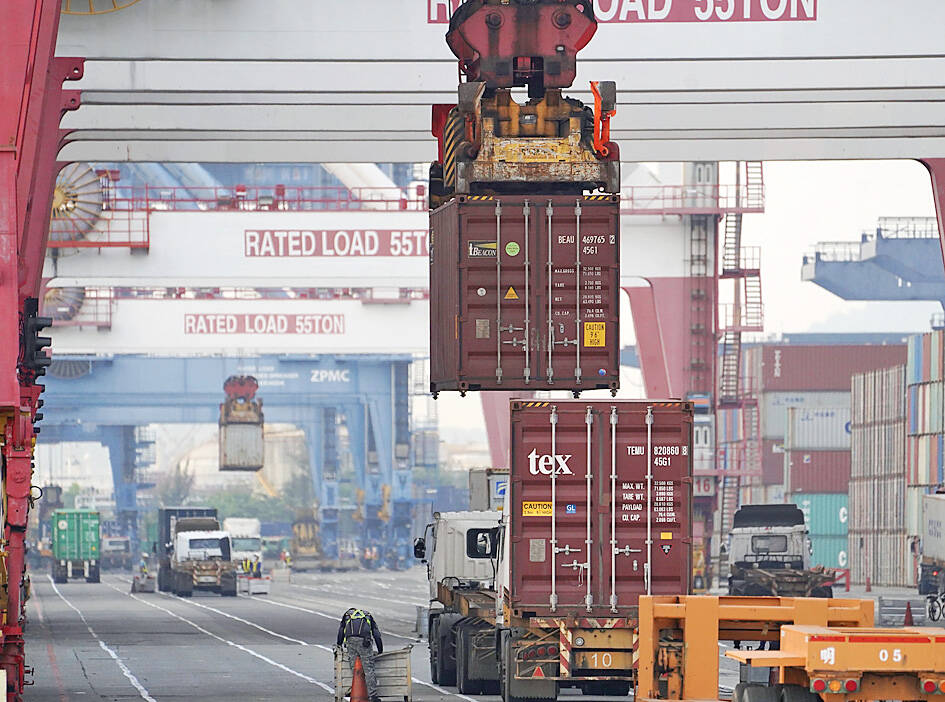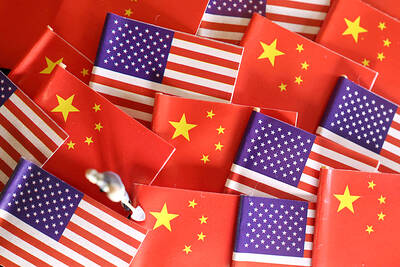Taiwan’s resilient domestic economy and the government’s support of the local semiconductor industry contributed to the country’s strong per capita GDP, experts said on Sunday.
Their analyses came in the wake of an IMF projection that said Taiwan’s per capita GDP is expected to become the highest in East Asia this year, partly because of its relatively stable currency.
The IMF’s latest report showed that Taiwan’s per capita GDP is set to increase from US$33,140 last year to about US$35,510 this year, surpassing Japan for the first time and South Korea’s for the first time since 2003.

Photo: CNA
South Korea’s per capita GDP is forecast to drop by an annual 4 percent to about US$33,590 this year, while Japan’s is projected to fall 12.6 percent to about US$34,360, the report said.
The National Development Council said that a relatively stable New Taiwan dollar was a major factor in the strong per capita GDP, but added that Taiwan’s solid economic resilience was also a factor.
Darson Chiu (邱達生), a research fellow at Taiwan Institute of Economic Research’s (TIER, 台灣經濟研究院) Department of International Affairs, said that in addition to the stable foreign-exchange factor, Taiwan’s economic transformation also contributed to the high per capita GDP growth.
That transformation was achieved with the return of overseas Taiwanese businesses, which helped expand production and increase investment in Taiwan, he said.
Japan’s per capita GDP fell below US$40,000 in 2020, after reaching that mark a year earlier, and it has continued to fall due to a sharp depreciation of the yen this year, the COVID-19 pandemic, and the effects of a trade dispute between the US and China, Chiu said.
South Korea’s economy has also shown sluggish growth since 2019, due mainly to the US-China trade dispute, he added.
Central bank data showed that the NT dollar has dropped 13.15 percent against the greenback so far this year, while the won has plunged 16.78 percent and the yen has plummeted 21.95 percent.
Dachrahn Wu (吳大任), director of National Central University’s Research Center for Taiwan Economic Development, said that the foundation for Taiwan’s healthy per capita GDP growth this year had been laid over the past two years.
After the outbreak of COVID-19 in 2020, Taiwan’s successful management of the pandemic and the retention of normal operations in the high-tech sector lent support to domestic growth, despite the global slowdown, Wu said.
During that period, Taiwan’s important role in the global semiconductor industry fell into the international spotlight, particularly amid a global shortage of semiconductors last year, Wu added.
However, C.C. Wei (魏哲家) — CEO of the world’s largest contract chipmaker, Taiwan Semiconductor Manufacturing Co (台積電) — told an investors’ conference on Thursday last week that chipmakers might see a slump in demand next year, and observers are concerned about how that would affect Taiwan’s economy.
Arisa Liu (劉佩真), a researcher at TIER’s Taiwan Industry Economics Database, said the semiconductor industry is facing three major challenges, with the main one being its worst downward cycle in a decade, which would test the ability of businesses in the supply chain to adapt.
Meanwhile, the US is expected to step up its restrictions on China, which would cripple its semiconductor industry and might limit the operating flexibility of foreign suppliers, Liu said.
Taiwanese chipmakers might also come under mounting pressure to decentralize their production facilities, amid tensions across the Taiwan Strait, as many countries become increasingly aware of the importance of supply chain resilience, she added.
Taiwan had earned a name as one of the four “Asian Tigers,” alongside Hong Kong, Singapore and South Korea, based on its rapid economic growth from the 1960s to the 1990s.
In 1992, Taiwan’s per capita GDP reached US$10,000, while South Korea’s was US$8,000.
However, Taiwan’s economy began to weaken later in the 1990s, as a large number of Taiwanese companies started moving their production operations to China due to wage hikes and soaring domestic production costs.
South Korea also took a hit later in the 1990s, registering negative economic growth in 1997 during the Asian financial crisis.
However, the South Korean government introduced stimulus measures and reforms that spurred rapid economic growth in 1999 and 2000, and in 2003, its per capita GDP surpassed Taiwan’s, mainly on the back of its manufacturing sector.
At that time, Taiwan’s economy was sluggish due to the exodus of Taiwanese businesses, said Tsai Yu-tai (蔡鈺泰), head of the Statistics Department at the Directorate-General of Budget, Accounting and Statistics.

‘SWASTICAR’: Tesla CEO Elon Musk’s close association with Donald Trump has prompted opponents to brand him a ‘Nazi’ and resulted in a dramatic drop in sales Demonstrators descended on Tesla Inc dealerships across the US, and in Europe and Canada on Saturday to protest company chief Elon Musk, who has amassed extraordinary power as a top adviser to US President Donald Trump. Waving signs with messages such as “Musk is stealing our money” and “Reclaim our country,” the protests largely took place peacefully following fiery episodes of vandalism on Tesla vehicles, dealerships and other facilities in recent weeks that US officials have denounced as terrorism. Hundreds rallied on Saturday outside the Tesla dealership in Manhattan. Some blasted Musk, the world’s richest man, while others demanded the shuttering of his

ADVERSARIES: The new list includes 11 entities in China and one in Taiwan, which is a local branch of Chinese cloud computing firm Inspur Group The US added dozens of entities to a trade blacklist on Tuesday, the US Department of Commerce said, in part to disrupt Beijing’s artificial intelligence (AI) and advanced computing capabilities. The action affects 80 entities from countries including China, the United Arab Emirates and Iran, with the commerce department citing their “activities contrary to US national security and foreign policy.” Those added to the “entity list” are restricted from obtaining US items and technologies without government authorization. “We will not allow adversaries to exploit American technology to bolster their own militaries and threaten American lives,” US Secretary of Commerce Howard Lutnick said. The entities

Minister of Finance Chuang Tsui-yun (莊翠雲) yesterday told lawmakers that she “would not speculate,” but a “response plan” has been prepared in case Taiwan is targeted by US President Donald Trump’s reciprocal tariffs, which are to be announced on Wednesday next week. The Trump administration, including US Secretary of the Treasury Scott Bessent, has said that much of the proposed reciprocal tariffs would focus on the 15 countries that have the highest trade surpluses with the US. Bessent has referred to those countries as the “dirty 15,” but has not named them. Last year, Taiwan’s US$73.9 billion trade surplus with the US

Prices of gasoline and diesel products at domestic gas stations are to fall NT$0.2 and NT$0.1 per liter respectively this week, even though international crude oil prices rose last week, CPC Corp, Taiwan (台灣中油) and Formosa Petrochemical Corp (台塑石化) said yesterday. International crude oil prices continued rising last week, as the US Energy Information Administration reported a larger-than-expected drop in US commercial crude oil inventories, CPC said in a statement. Based on the company’s floating oil price formula, the cost of crude oil rose 2.38 percent last week from a week earlier, it said. News that US President Donald Trump plans a “secondary